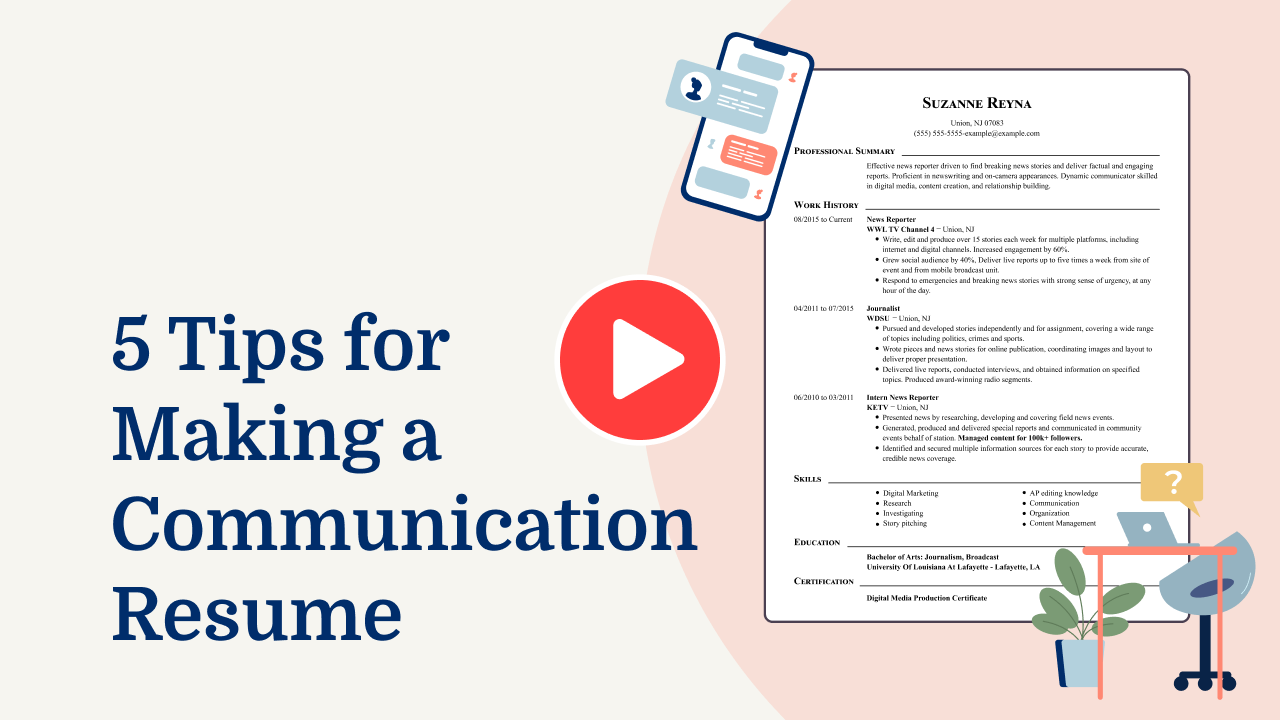Why this resume works
- Quantifies accomplishments: Measurable accomplishments like increasing blog traffic by 35% and boosting client engagement by 25% showcase the applicant’s tangible impact.
- Showcases career progression: Starting as a web content specialist and progressing to a blogger role shows the applicant’s career growth through increasingly challenging responsibilities.
- Highlights industry-specific skills: Specializing in SEO optimization and content strategy, the applicant highlights industry-specific skills essential for thriving in digital marketing roles.
More Blogger Resume Examples
Check out our blogger resume examples to see how to showcase your writing skills, content creation experience, and unique voice. These media and communication resume samples will guide you in crafting a resume that attracts potential employers in the digital space.
Entry-Level Blogger
Why this resume works
- Puts skills at the forefront: The skills-based resume format effectively puts skills like SEO optimization and content strategy right at the top, ideal for those just starting.
- Shows digital literacy: Using tools such as Google Analytics and social media management, the applicant shows strong computer skills and digital literacy, which is essential in today’s tech-driven job market.
- Effective use of keywords: By including role-relevant keywords like “SEO optimization” and “content strategy,” the applicant improves their chances of passing ATS filters.
Mid-Level Blogger
Why this resume works
- Points to measurable outcomes: By showcasing metrics like a 35% traffic boost and 10K monthly views, the applicant emphasizes their ability to deliver strong results through targeted strategies.
- Demonstrates language abilities: Language skills in Spanish, French, and Japanese reflect adaptability for global audiences, supporting cross-cultural engagement.
- Includes a mix of soft and hard skills: Pairing technical expertise like SEO with collaboration-driven interpersonal skills demonstrates a balance between analytical precision and relationship-building abilities.
Experienced Blogger
Why this resume works
- Focuses on work history: By using a chronological resume format, the applicant clearly maps out a career path, showcasing growth and expertise through progressively responsible roles from copywriter to blogger.
- Lists relevant certifications: Listing multiple certifications, like SEO Fundamentals and Content Marketing Certification, shows an ongoing commitment to mastering industry trends and improving content creation skills.
- Emphasizes leadership skills: Organizing large-scale blogger meetups highlights leadership skills by bringing together a community of over 300, demonstrating initiative and networking prowess.
Blogger Resume Template (Text Version)
Aiko Brown
Greenfield, IN 46148
(555)555-5555
Aiko.Brown@example.com
Professional Summary
Dynamic blogger with a robust background in content strategy, SEO optimization, and digital marketing. Proven record of boosting engagement and traffic.
Work History
Blogger
Digital Insight Hub – Greenfield, IN
August 2023 – August 2025
- Increased blog traffic by 35% in one year
- Developed 50+ engaging blog posts monthly
- Collaborated with 10+ industry experts for content
Content Writer
Creative Writes Co. – Greenfield, IN
May 2020 – July 2023
- Boosted client engagement by 25% with unique content
- Drafted 100+ articles on tech advancements
- Optimized content for SEO, increasing visibility
Web Content Specialist
Innovative Media Group – Indianapolis, IN
January 2019 – April 2020
- Managed content for a site with 10K daily visitors
- Led a team of 5 in delivering SEO-driven articles
- Enhanced user engagement metrics by 40%
Languages
- Spanish – Beginner (A1)
- French – Beginner (A1)
- Mandarin – Beginner (A1)
Skills
- SEO Optimization
- Content Strategy
- Copywriting
- Analytical Research
- Digital Marketing
- Social Media Engagement
- Brand Development
- Project Management
Certifications
- Certified Content Marketing Specialist – Content Marketing Institute
- SEO Fundamentals – Semrush Academy
Education
Master’s Communications
University of California, Berkeley Berkeley, California
June 2018
Bachelor’s Journalism
University of Washington Seattle, Washington
June 2016
Related Resume Guides
Advice for Writing Your Blogger Resume
Explore our advice on how to write a resume tailored for a blogger position and discover how to highlight your creative flair, storytelling skills, and digital expertise. Whether you’re crafting compelling content or building an engaged audience, these resume-writing tips will help you stand out in the blogging world.

Showcase your portfolio or projects
For a blogger, showcasing your portfolio or projects on your resume is essential. This helps potential clients or employers see the quality of your work and understand your style and expertise.
Linking to an online portfolio on platforms like Behance, Dribbble, or a personal website can make it easy for them to browse through your projects. Including select projects directly in your resume also highlights specific achievements and contributions.
A well-structured project showcase is especially important for artistic and creative roles like blogging because it provides concrete examples of your writing skills, creativity, and ability to engage an audience. Your portfolio should include freelance work, academic projects, and side projects as they are all valid demonstrations of your abilities.
Each project entry should be detailed similarly to work experience entries with the project name, client or company (if applicable), a brief description, and key contributions and impact.
When listing these details in your resume, focus on how each project showcases different aspects of your blogging skills. Describe what you did and the results you achieved, such as increased engagement or positive feedback from readers. This approach not only proves your capabilities but also shows that you have practical experience in delivering compelling content across various contexts.
Example of a projects section
Vegan Recipe Blog Launch
Personal Project
March 2022
- Developed and launched a vegan recipe blog that attracted over 10,000 monthly visitors within six months.
- Created engaging content by writing weekly posts and shooting high-quality food photography.
- Implemented SEO strategies that improved organic search rankings and increased site traffic by 30%.
Travel Blogging Collaboration
Wanderlust Journeys
July 2021 – December 2021
- Partnered with Wanderlust Journeys to create a series of travel blogs featuring destinations across Europe.
- Produced visually appealing content that boosted the client’s social media following by 15%.
- Worked alongside local guides to provide authentic experiences and insights for readers.
Get great ideas for your resume by checking out professional resume examples. They show you how to organize your information in a way that looks good and gets noticed.
Emphasize your most relevant skills
For a blogger role, both technical and soft skills play an important part in showcasing your ability to create compelling content. Highlighting your technical skills, like experience with content management systems, SEO tools, or photo editing software, can show that you know how to handle the practical side of blogging.
At the same time, soft skills such as creativity, adaptability, and communication are key for connecting with audiences and developing engaging posts. Together, these skills demonstrate that you can manage the entire blogging process from idea creation to publication.
Consider adding a dedicated skills section to your resume where you can list tools like WordPress, Canva, or Google Analytics alongside artistic talents like storytelling or photography. This gives hiring managers a glance at what you bring to the table.
To make your resume even stronger, weave these abilities into your work experience. For example, instead of just saying “wrote blog posts,” say something like “created SEO-optimized blog posts that increased site traffic by 25%.” This approach ties your skills directly to results and makes them more memorable.
By mixing technical and creative strengths throughout your resume, you’ll paint a clear picture of how you’re equipped to succeed as a blogger while also standing out from other applicants.
Selecting a resume format that highlights writing skills, audience engagement, and content creation can help bloggers stand out.
Choose a professional resume template
When selecting a resume template for a blogger role, aim for one that combines creativity with professionalism. Choose a clean and structured design that organizes information clearly.
Look for templates with strong visual hierarchy, using bold headings and consistent spacing to make your skills, experience, and achievements easy to find. Avoid overly decorative elements like flashy fonts or busy graphics that may distract from your content.
It’s also important to pick a format that works well with applicant tracking systems (ATS). Many companies use these systems to scan resumes, so ensure the template is simple and avoids images or text boxes that could block key details. Stick to standard fonts like Arial or Calibri and use clear section titles.
For a blogging role, consider templates that let you highlight creative abilities without sacrificing readability. A minimalist design gives you room to focus on examples of your writing, social media expertise, or audience engagement while still looking polished and professional.
Create a standout resume quickly! Use our Resume Builder to mix and match templates and make your resume shine for any job.
Format your resume properly
Proper resume formatting is key to readability and a professional look. For a blogger with limited experience, use a functional resume to highlight your writing skills and creativity over job history. This format helps showcase abilities like content creation and social media management that are important for blogging success. Explore additional formatting tips below to start crafting your resume.
5 resume formatting tips
- Use clear section headings: Label sections like “work experience” and “skills” clearly for easy navigation.
- Choose consistent fonts: Select a readable font such as Arial or Calibri and stick with it throughout.
- Use bullet points: Present job duties and skills in bullet points to make scanning easier.
- Limit to one page: Keep the resume one page long, unless you have extensive experience to share.
- Ensure proper spacing and alignment: Maintain consistent spacing and alignment for a clean, professional presentation.
Make sure your resume gets noticed by using our ATS Resume Checker. It helps you format correctly and pick the right keywords so it can pass through ATS software easily.
FAQ
Do I need to include a cover letter with my blogger resume?
Yes, including a cover letter with your blogger resume can significantly impact your application. A cover letter lets you express your passion for blogging and highlight specific writing experiences that align with the blog or company’s niche.
For example, if you’re applying to a travel blog, share insights from your travel experiences or discuss a particular post you’ve written that resonated well with readers. Consider using our Cover Letter Generator to craft a personalized cover letter.
Additionally, reviewing cover letter examples tailored for content creators can provide inspiration and structure.
How long should a blogger’s resume be?
For a blogger, a one-page resume is often sufficient to highlight your creativity, writing skills, and digital presence. Focus on showcasing your most powerful blog posts, knowledge of SEO, and any collaborations with brands or influencers.
If you’ve been blogging for several years or have diverse experiences in different niches, you might consider a two-page resume to ensure all significant achievements are covered.
Ultimately, how long a resume should be depends on the depth of your experience and the roles you’re targeting. Explore our guide for examples and tips tailored to determining the ideal length at various career stages.
How do you write a blogger resume with no experience?
When creating a resume with no experience for a blogger, focus on showcasing your skills and passion for writing. Include any relevant projects that illustrate your ability to excel in the role.
- Showcase your writing skills: Include links to any personal blogs, guest posts, or articles you’ve written. This provides tangible evidence of your ability to engage readers and produce content.
- Focus on education and courses: List any relevant courses or workshops you’ve completed in areas like creative writing, digital marketing, or social media management. If you have a degree in journalism, English, or communications, make sure it’s prominently featured.
- Highlight transferable skills: Emphasize skills like creativity, research skills, SEO knowledge, and social media expertise. These are valuable traits for bloggers even without formal job experience.
For more guidance on crafting a resume with no experience tailored to the blogging field, consider exploring templates designed specifically for entry-level positions.
Rate this article
Blogger
